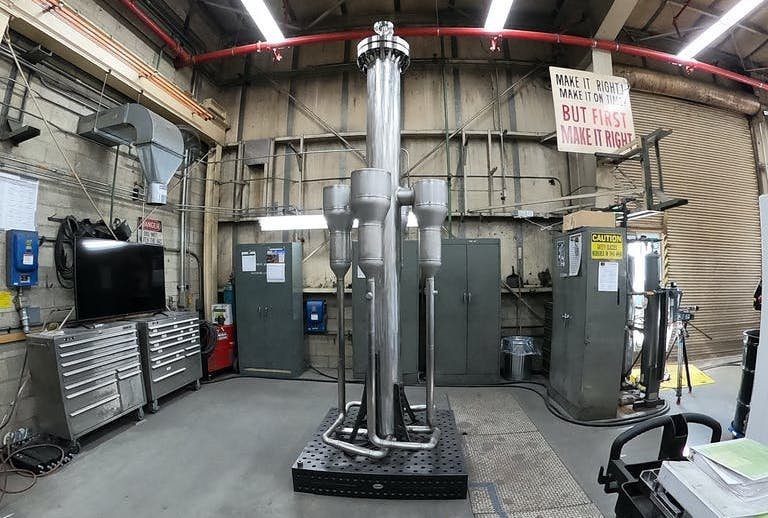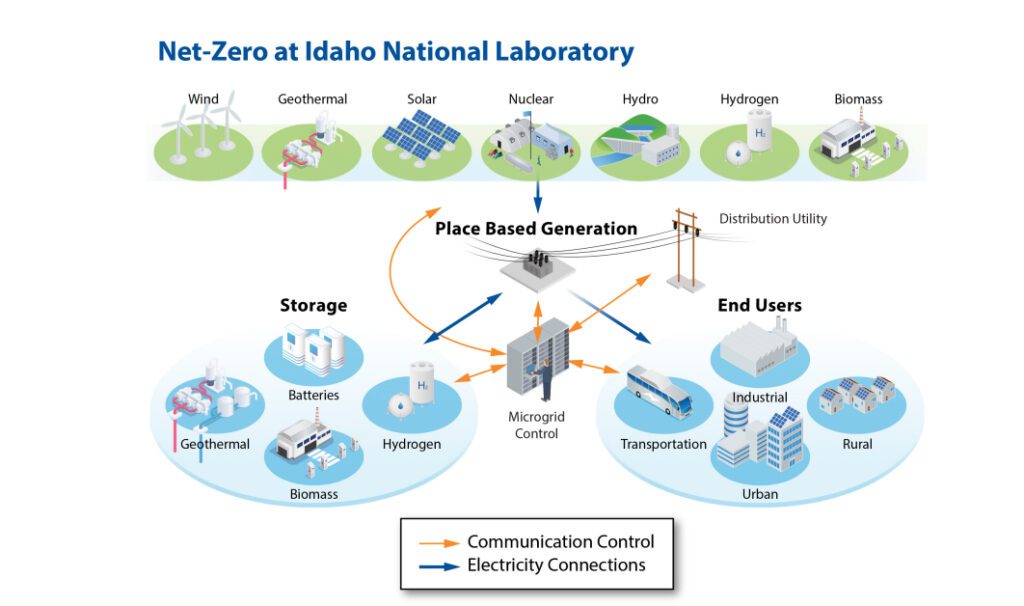INL Mulling Building New Nuclear Reactor to Energize Net-Zero Campus Microgrid

Idaho National Laboratory (INL) is exploring designing, building, and operating an onsite nuclear reactor resource as part of a broader effort to achieve net-zero emissions at its sprawling campus in Idaho Falls by 2031.
Battelle Energy Alliance (BEA), an entity that manages and operates the Department of Energy (DOE) national laboratory, on April 29 launched a request for information (RFI) from industry, utilities, energy users, and other stakeholders that could inform how it can integrate nuclear-generated power and heat into a campus microgrid. The initiative falls under the April 2021-launched INL Net-Zero Program, which aims to eliminate or offset all emissions from the campus where 5,400 employees work.
The quest to achieve net-zero in less than a decade will serve as a crucial demonstration of a decarbonization pathway that would utilize technology innovations, collaborations, increased efficiencies, and novel approaches," BEA suggested. The city-like INL campus already has 100 miles of transmission lines, a landfill, a 605-vehicle fleet, 357 buildings, and hundreds of miles of roads. Moreover, we are developing the INL site electrical infrastructure in preparation for the next 50 years of mission growth," BEA said.
If it achieves net-zero, INL would effectively become a national carbon-neutral prototype," it added. To achieve the goal, BEA said it is prepared to demonstrate integrating advanced nuclear reactors and other clean energy systems on a net-zero microgrid to provide clean electricity, thermal energy, hydrogen, ammonia, and/or other value-added products to achieve our carbon-reduction goals." A key part of the vision entails introducing-through demonstrations, pilots, and eventually campus-wide implementation-energy from multiple sources, including small modular reactors (SMRs) and microreactors, into the campus's transmission and distribution systems.
Nuclear Power and Heat at the Core of Net-Zero PlanIn its RFI, BEA sought input on nuclear technology options that could provide power and heat to replace other sources of electrical and thermal energy used at the site. It said it intends to use heat, including high-temperature energy from reactor cooling loops and waste heat, for high- and low-temperature electrolysis, hydrogen production, synthetic fuel processing, as well as facility heating. BEA sought technology suggestions, requesting details about reactor type, operating temperatures, capacity, size, fuel supply, ramping capability, technology readiness, licensing status, cost, and schedule.
While nuclear will be at the core of the effort to demonstrate a reliable, resilient transition, the program will also incorporate concepts to empower isolated microgrids (of up to 15 MWe at peak) at specific campuses, electric vehicle (EV) deployment-from passenger cars to heavy equipment-as well as the development and deployment of alternative energy standby generators. That's why the forward-looking vision must also take into account increasing future demand, which could approach 95 MWe by 2031 and soar beyond 100 MWe in the future, BEA said.
If INL can achieve net-zero, the campus could serve as a testbed," becoming a singular opportunity" for industry to prove components and test control systems, BEA said. We anticipate exporting the fundamental design of the microgrid to future locations, such as stand-alone industrial parks, commercial facilities, and remote locations requiring net-zero carbon resources, to reliably meet energy demands through nuclear energy," it said.
 INL is considering several net-zero solutions. Source: INLComplying with the Current Electric Service Agreement
INL is considering several net-zero solutions. Source: INLComplying with the Current Electric Service AgreementINL's grid, which is operated and maintained by the INL Power Management Team, is currently powered by Idaho Power Corp. (IPC), a regulated local utility that has the sole right to supply power to INL under a contract with the DOE. Over 2020, INL consumed about 190 GWh, power IPC provided under the electric service agreement with the DOE, which is valid until September 2031. The IPC contract held by DOE allows for DOE and INL tenants to generate onsite power and potentially even offset all of INL's energy use. However, the contract also precludes third parties (e.g., reactor owners) from interconnecting generating resources at INL without IPC's permission," the BEA explained. Thus, it may be necessary for reactor owners to partner with IPC based upon specific details of the proposed services provided to INL."
In addition, the power contract allows the DOE to request additional power beyond 65 MW with an 18-month lead time. But while IPC has initiated efforts to provide additional capacity to meet peak demand through at least 2031, BEA's effort to build new nuclear sources could be limited by contractual obligations.
If INL's power system's generation exceeds real-time demand, the surplus power would trigger a net-power export to the IPC portion of the bulk electric system (BES), which could potentially involve federal regulation, BEA explained. To enable possible power export to the BES, a utility corridor would need to be constructed and connected to a switching station on the BES," it said.
That's why in the RFI, BEA asked stakeholders about their experience with agencies like the Federal Energy Regulatory Commission, the North American Reliability Corp., and the Western Electricity Coordinating Council. It also asked for input on how firms would interface with local power providers so that the DOE can continue to comply with the electric service agreement with IPC. In one question, it asked: How will your firm connect to the BES without exporting power through the INL power grid if the utility corridor is not in place when your demonstration project is ready?" The RFI also explored business models, including whether private or public sector users would be interested in purchasing power from INL's Net-Zero nuclear energy project."
INL Has Long Been a Nuclear PioneerThe effort is noteworthy for INL, which launched in 1949 on its 890-square-mile desert site with a mission to develop civilian and defense nuclear reactor technologies and management of spent nuclear fuel. It has over its long history hosted 52 pioneering nuclear reactors projects, including the EBR-1, the first reactor to generate usable amounts of electricity.
The lab is today an established epicenter for emerging nuclear technologies. Leveraging its Advanced Test Reactor and Materials and Fuels Complex research capabilities, the lab also hosts a number of programs to foster innovation in nuclear energy, including the GAIN Initiative, Advanced Nuclear Fuels, Nuclear Reactor Systems, Fuel Cycle Technologies, Space Power Systems, Light Water Reactor Sustainability, and the National Reactor Innovation Center.
The lab is also a hot spot for several pioneering projects. These include INL's own MARVEL microreactor, a 100-kW sodium-potassium cooled reactor that will test microreactor applications when it is connected to the world's first nuclear microgrid at INL by 2024," the DOE said. INL is also slated to demonstrate full operation of Project Pele, a Department of Defense microreactor.
 Idaho National Laboratory (INL) recently built a full-scale, electrically heated prototype to support the U.S. Department of Energy's new MARVEL microreactor project. The prototype is one of the largest components ever machined at the lab and will be used to help validate the project's final microreactor design that could be operational within the next two years. This image shows the MARVEL microreactor prototype at INL's Materials and Fuels Complex's machine shop. Courtesy: INL
Idaho National Laboratory (INL) recently built a full-scale, electrically heated prototype to support the U.S. Department of Energy's new MARVEL microreactor project. The prototype is one of the largest components ever machined at the lab and will be used to help validate the project's final microreactor design that could be operational within the next two years. This image shows the MARVEL microreactor prototype at INL's Materials and Fuels Complex's machine shop. Courtesy: INLOther pivotal demonstration projects at the INL site include the Molten Chloride Reactor Experiment, which is being spearheaded by Southern Co. and could be operational by 2026; Oklo's use of recycled high-assay, low-enriched uranium (HALEU) in a full-size Aurora microreactor; and the construction and operation of the 462-MWe Carbon-Free Power Project (CFPP), which will use six NuScale VOYGRs. In February, CFPP's developers announced completion of field investigation activities at its INL site. The project is reportedly on schedule for a 2029 startup.
According to INL Director John Wagner, INL's demonstration of net-zero solutions, including the integration of advanced reactors on a campus microgrid, will be pivotal to the lab's initiatives to explore nuclear's power and heat capabilities. Nuclear energy is absolutely essential to achieving national and international net-zero goals," Wagner said. We see this work as not only a core part of our mission, but also an opportunity to lead by example and reduce barriers to deploying emission-free nuclear energy technologies to local and global communities."
-Sonal Patelis a POWER senior associate editor (@sonalcpatel,@POWERmagazine).
The post INL Mulling Building New Nuclear Reactor to Energize Net-Zero Campus Microgrid appeared first on POWER Magazine.